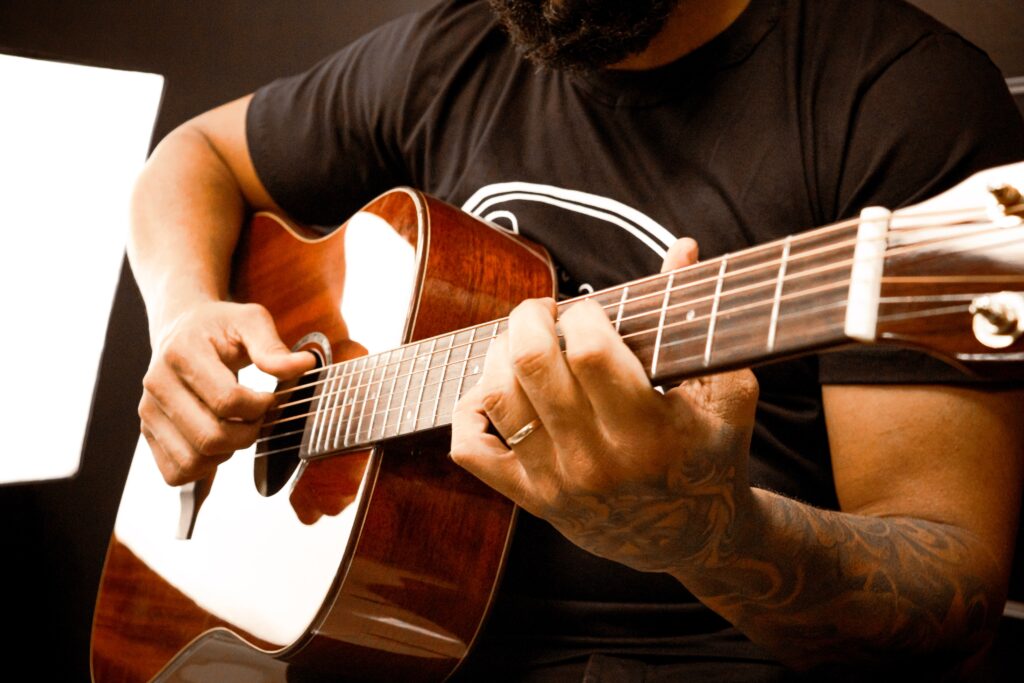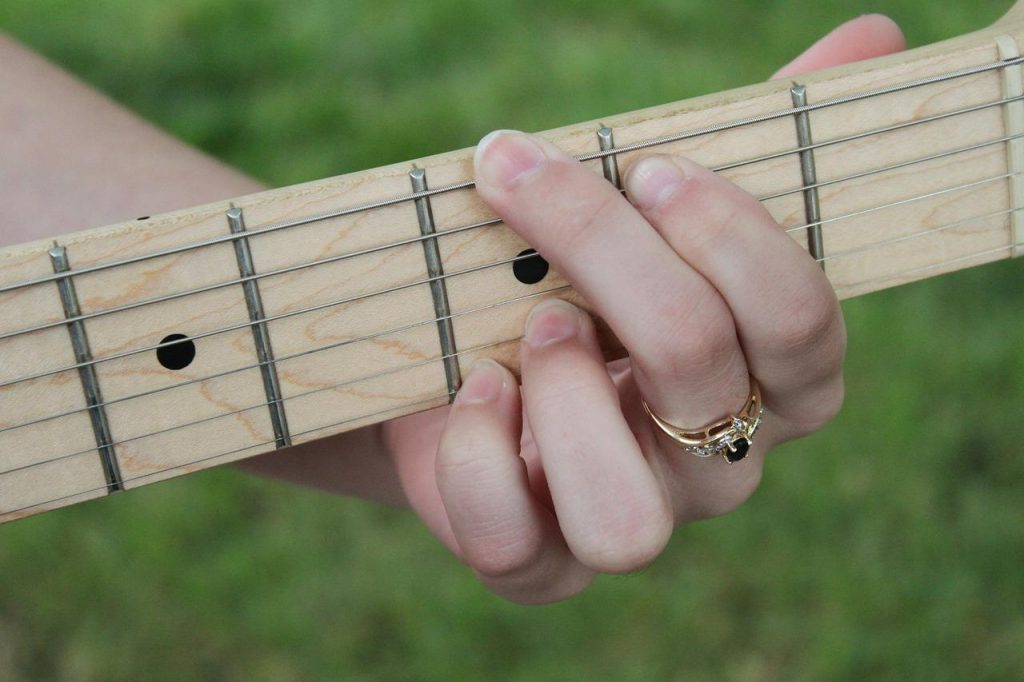Want to transfer your acoustic guitar playing expertise to live performances? If that’s your desire, an acoustic-electric guitar is an invention you would want to invest in.
An acoustic-electric guitar will amplify your sound, allow you to move freely on the stage as you entertain your audience, and maintain your energy levels high.
What is an Acoustic-Electric Guitar?
It is a standard acoustic guitar consisting of an onboard microphone or a pickup system. The idea is to connect the guitar to an amplifier and play it through a PA system or speaker. It’s used in various music genres, especially live performances where sound and high volume are required.
Pickup System Types
You can amplify an acoustic guitar without using a regular mic.
How so?
By using any of the following pickup systems:
- Piezo-electric transducer – You need to place it under the string’s saddle, at the bridge. A power source and onboard preamp are necessary.
- A magnetic bar-shaped pickup – It fits at the soundhole, under the strings, and doesn’t require any guitar alternations.
- A tiny electret condenser mic is inside the guitar.
History of an Acoustic-Electric Guitar
Acoustic guitars have been used in live bands since the 1920s. However, there was a need to amplify the guitars’ sound since drums and drum beats outplayed them. It necessitated the amplification of guitar vibrations electrically.
In 1910s.attempts were made to amplify telephone transmitters by using banjos and violins inside. However, the resultant signal was weak.
In the 1920s, hobbyists experimented with carbon button microphones on guitar bridges for amplification.
Lloyd Loar is known to be the first person to create an electric pickup system for an acoustic guitar in the 1930s. The founder of the Vivi-tone company invented a removable drawer that would slide from the acoustic guitar’s bass rim. Signals would be transmitted from the wooden bridge to the metal plate, generating electric output and amplifying vibrations.
However, electric pickups were commercially available in the 1930s through Harry DeArmond’s FHC.
Is acoustic-electric the same as acoustic?
You may not tell the difference between an acoustic-electric guitar and an acoustic guitar by looking at them.
In comparison, both have the same physical construction and acoustic sound. The only difference is the electronic components fitted in an acoustic-electric guitar.
The components can be; a Piezo pickup, a magnetic pickup, an inbuilt preamp, and a microphone. The battery-charged preamps mostly have inbuilt equalizers, tone controls, and tuners.
You can plug it into a mixer, speaker, PA system, or amplifier with the electric option.
The piezoelectric pickups have a preamplifier fixed on the guitar body to enhance the signal of the guitar amplifier.
The preamplifiers have a tuner, tone controls of different types, and equalizers containing six or more frequency bands.
An acoustic guitar is a conventional six-stringed musical instrument played using a pick. It doesn’t require an amplifier or electricity.
Is acoustic-electric the same as electric?
No, acoustic-electric and electric guitars are not the same. Acoustic-electric guitars have a built-in pickup system that allows the guitar to be plugged into an amplifier or sound system, allowing for amplified sound.
Electric guitars do not require any special hardware and typically produce their sound by being plugged into an amplifier. Both types of guitars are capable of making a wide range of sounds depending on how they are played and what type of effects or amplification is used.
Additionally, electric guitars tend to have higher action than acoustic-electric guitars, meaning the strings require more force to be pushed down on the frets.
Ultimately, choosing between an electric or an acoustic-electric guitar depends on your playing style and what type of sound you want to produce.
Electric guitars can offer a variety of rhythms and tones through their pickups and effects pedals but may be too loud for certain types of music.
Acoustic-electric guitars are perfect for both unplugged performances as well as amplified sounds, making them versatile instruments for any musician.
Whichever type of guitar you decide to go with, remember that practice makes perfect and the most important part is having fun!
Why should I choose an acoustic-electric guitar?
Amplifying your guitar without using a separate microphone is not the only advantage of considering an acoustic-electric guitar.
Further, when using an ordinary microphone, you need to consider other factors like the type of microphone, positioning, polar pattern, and effects of guitar movements on the sound; these would limit the guitarist’s movement during the performance.
However, you can plug yours into a mixing console or an amplifier with an in-built pickup system.
That’s not all. When you use it in such a manner, you get a consistent tone output, especially in live events when you may not have too much time to check the sound of separate microphones before or during the show.
With an acoustic-electric guitar, the pickup system allows easy sound control at high volumes with freedom of movement.
What are the Pros and Cons of using an acoustic-electric guitar?
Pros:
- You will achieve a better sound projection
- Your harmonic tones will be more amplified
- You can enjoy your live performances while moving around on the stage
- You can customize your sounds
- They are affordable
Cons:
- The need to have a power source to play your guitar is limiting.
- You will need to replace electronic parts in the system that fail to play amplified.
- They are better for live bands. Purchasing this type of personal entertainment may not be a good investment.
- You may require extra accessories to play plugged-in.
Is an acoustic-electric guitar good for beginners?
Different people argue differently. Some beginners prefer acoustic, while others prefer acoustic-electric. But here’s the interesting thing: neither of the arguments above is true.
Your choice depends on your preference.
What kind of strings should you use for an acoustic-electric guitar?
The best strings for an acoustic-electric guitar are typically medium gauge (also known as light/medium gauge) strings, which offer a balance between bright and mellow tones.
Heavier gauge strings will provide more volume and sustain but can be harder to play. Lighter gauge strings may produce less sound but will also make the guitar easier to play. It’s important to experiment with different string types to find the ones that work best for your style of playing and desired sound.
Additionally, keep in mind that the type of wood used in your acoustic-electric guitar affects the tone you’ll get out of it!
Steel or bronze strings tend to have brighter, sharper tones while nylon or fluorocarbon strings can be warmer and richer.
What do I need to play an acoustic-electric guitar?
To play an acoustic-electric guitar, you will need a few basic items.
Firstly, you will need the guitar itself: most acoustic-electric guitars come with built-in pickups and preamps, allowing them to be plugged into amplifiers or sound systems. You may also want to consider investing in some higher-quality strings that are suitable for your playing style.
Next, you will need an amplifier or sound system designed to handle the signal coming from the guitar’s pickup. This could be a simple practice amp or a more complex setup for live gigs. Make sure it has enough power for both acoustic and electric sound.
It is also recommended to have some effects pedals on hand such as distortion, reverb, echo, and more. These can help shape your tone and give it character.
Additionally, having access to an EQ pedal can help control the volume balance between different frequencies of sound when playing live shows or recording in a studio.
Finally, make sure you have some accessories like strap locks, cable ties, and picks so that you are always prepared when practicing or performing with your instrument.
With all of these components in place, you should be ready to start playing your acoustic-electric guitar!
| Question | Answer |
|---|---|
| What kind of cable do I need to connect my acoustic-electric guitar to an amplifier or sound system? | You will need a 1/4 inch instrument cable to connect your acoustic-electric guitar to an amplifier or sound system. Make sure to choose a high-quality cable with good shielding to prevent interference and ensure a clear sound. |
| Do I need a specific type of amplifier or sound system? | While you can use any guitar amplifier or sound system to amplify your acoustic-electric guitar, some amplifiers, and sound systems are specifically designed for acoustic-electric guitars and may offer additional features such as built-in effects and EQ controls. |
| Can I play an acoustic-electric guitar without an amplifier or sound system? | Yes, you can play an acoustic-electric guitar without an amplifier by playing it acoustically, like a traditional acoustic guitar. However, the sound will be quieter and may not project as well in a live performance setting. |
| Should I use an external tuner with an acoustic-electric guitar? | While many acoustic-electric guitars have built-in tuners, it can be helpful to use an external tuner for more accurate and precise tuning. Some guitar amplifiers and sound systems also have built-in tuners for convenience. |
Can you use an acoustic-electric guitar without an amp?
Yes, you can use an acoustic-electric guitar without an amp. Many acoustic-electric guitars come with built-in soundholes which allow them to produce a natural sound when played unplugged.
Additionally, they typically have higher tension strings than traditional acoustic guitars, resulting in fuller and louder tones when played acoustically.
However, if you want more volume or depth of tone when playing unplugged, then using an amp may be beneficial. An amp will also allow you to shape the tone of your instrument with effects pedals and other equipment like EQs for live performances or studio recordings.
Ultimately, it is up to the individual musician to decide whether they prefer the sound of their acoustic-electric guitar plugged into an amplifier or unplugged. Either way, you should be able to get the sound you are looking for with the right setup!
How can I make my acoustic-electric guitar sound better?
One way to make your acoustic-electric guitar sound better is by using the right strings. Different string gauges and materials will affect the sound of your guitar in different ways, so experimenting with different kinds will be key to finding the perfect tone.
Another way to improve your instrument’s sound is by keeping it properly tuned and maintained. Regularly cleaning and oiling the hardware on your guitar will help keep it sounding as good as possible for longer periods. Additionally, changing your strings regularly can help maintain a brighter tone, reduce buzzing, and keep intonation consistent.
Using effects pedals can also be a great way to shape the sound of your acoustic-electric guitar. Distortion, reverb, echo, and other types of effects can add a unique flavor to your tone that cannot be achieved any other way. Experimenting with different pedals is key in finding what works best for you and how you want to portray yourself musically.
Finally, utilizing high-quality amps and speakers when plugging into an amplifier is essential for getting great sound out of your acoustic-electric guitar.
Investing in gear that has been specifically designed to handle acoustic instruments will ensure that you get clear tones with plenty of depth and clarity no matter where you are playing or recording from.
Do acoustic-electric guitars sound good unplugged?
Yes, acoustic-electric guitars typically produce a good sound when unplugged. Compared to regular acoustic guitars, acoustic-electric guitars are typically equipped with higher tension strings that generate full and loud tones even in their unplugged form.
This is especially true when playing chords or strumming, as the added tension of the strings will allow more complex chords to come out clearer and louder than on traditional acoustic guitars.
Additionally, these instruments often have a bolder tone that is perfect for live performances or recording sessions. Acoustic-electric guitars will generally have a well-balanced low end, clear mid-range frequencies, and vibrant highs that help bring out the nuances of each note.
Overall, acoustic-electric guitars provide great sounding tones both unplugged and plugged in. Whether you are looking for mellow background music or loud lead performances, these instruments provide versatile sounds that will suit any style of playing.
What are the factors to consider when deciding what’ll work for you?
1. Price
The price of acoustic-electric guitars depends on the features, the brand, and the quality of the material used on the instrument.
The price could be a bit higher than acoustic guitars due to the extra equipment required for amplification.
However, it’s important to research when shopping, especially if you’re a first-time buyer, before spending on a guitar.
If you’re an experienced musician, you’re mostly sure about what you want in a guitar. Probably, it’s something you have been looking for and saving for.
The bottom line? They are affordable.
2. Size and Shape
Acoustic and acoustic-electric guitars have the same shape and form. Thanks to pickups, acoustic-electric allows you to choose a small or big size without worrying about sound projection. Above all, the acoustic-electric is the best if you consider size and shape.
3. Portability
Acoustic-electric guitars are played unplugged. However, walking around with amplification equipment can be tiresome and unnecessary if you don’t intend to use them.
Don’t feel guilty; that’s understandable. You can use guitar carrying bags with pockets for accessories to accommodate your luggage.
4. Appearance
Your guitar’s physical appearance is likely a factor to consider when shopping. The body of the guitar is vital to the sound. Manufacturers use tonewood for its overall impact.
Others prefer cheaper wood like basswood for its warm, full sound. Still, others choose mahogany for its durability and versatility.
Depending on your preference, the choice is yours.
5. Playability
Acoustic-electric guitars are easy to play. The steel strings are adjustable so as not to hurt your fingers. Ensure to replace your guitar strings timely.
They are playable for beginners and experienced musicians.
Wrap Up
From the origin to its suitability and a brief comparison to the acoustic type, the summary of what an acoustic-electric guitar is will be an essential guide to help you understand it.
When you read through, you will be sure to send your crowd into a tizzy if you choose to take your performance outside the walls.








